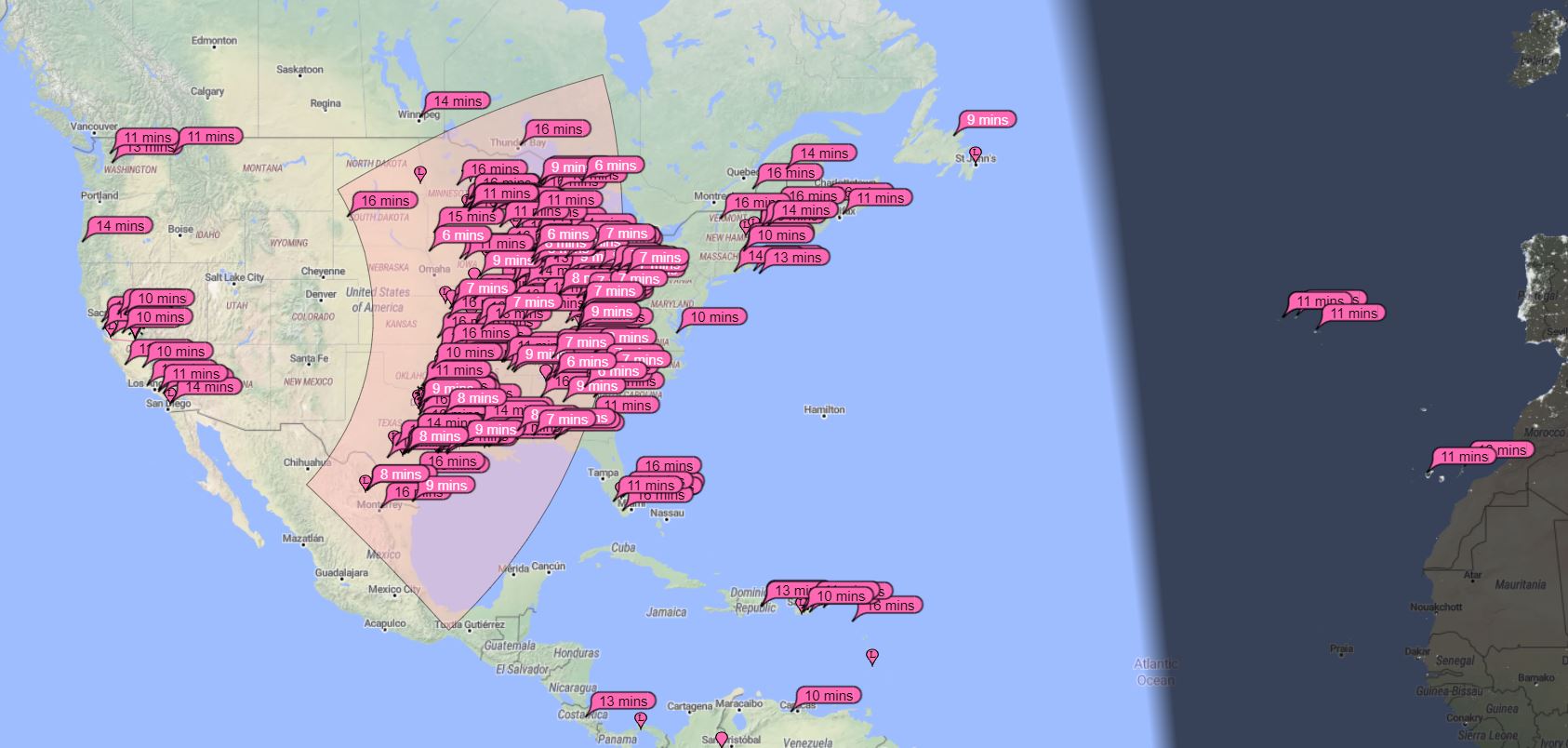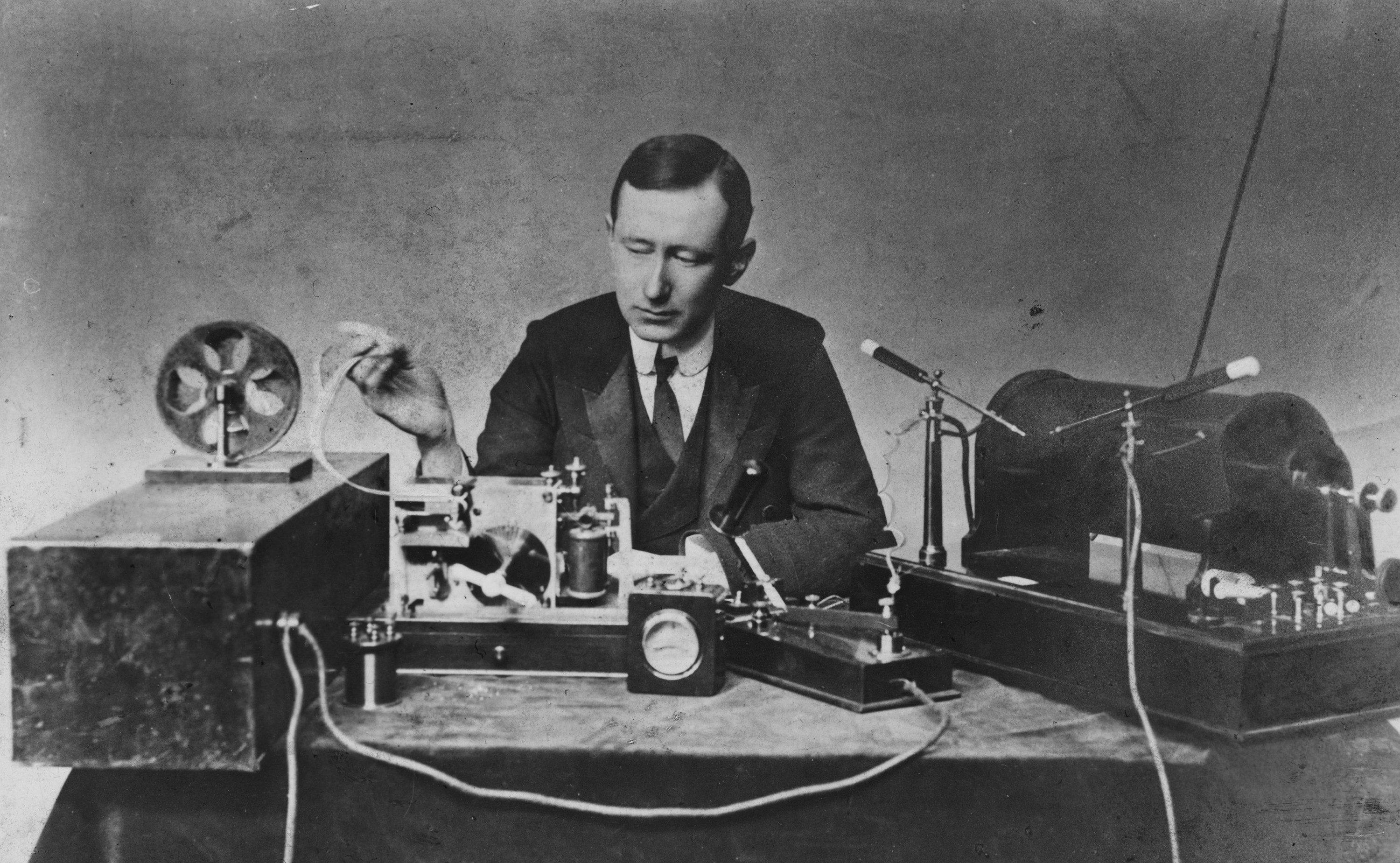|
Skywave
In radio communication, skywave or skip refers to the propagation of radio waves reflected or refracted back toward Earth from the ionosphere, an electrically charged layer of the upper atmosphere. Since it is not limited by the curvature of the Earth, skywave propagation can be used to communicate beyond the horizon, at intercontinental distances. It is mostly used in the shortwave frequency bands. As a result of skywave propagation, a signal from a distant AM broadcasting station, a shortwave station, or – during sporadic E propagation conditions (principally during the summer months in both hemispheres) – a distant VHF FM or TV station can sometimes be received as clearly as local stations. Most long-distance shortwave ( high frequency) radio communication – between 3 and 30 MHz – is a result of skywave propagation. Since the early 1920s amateur radio operators (or "hams"), limited to lower transmitter power than broadcast statio ... [...More Info...] [...Related Items...] OR: [Wikipedia] [Google] [Baidu] |
Near Vertical Incidence Skywave
Near vertical incidence skywave, or NVIS, is a skywave radio-wave propagation path that provides usable signals in the medium distances range — usually . It is used for military and paramilitary communications, broadcasting, especially in the tropics, and by radio amateurs for nearby contacts circumventing line-of-sight barriers. The radio waves travel near-vertically upwards into the ionosphere, where they are refracted back down and can be received within a circular region up to from the transmitter. If the frequency is too high (that is, above the critical frequency of the ionospheric F layer), refraction is insufficient to return the signal to earth and if it is too low, absorption in the ionospheric D layer may reduce the signal strength. There is no fundamental difference between NVIS and conventional skywave propagation; the practical distinction arises solely from different desirable radiation patterns of the antennas (near vertical for NVIS, near horizontal for conventio ... [...More Info...] [...Related Items...] OR: [Wikipedia] [Google] [Baidu] |
Radio Propagation
Radio propagation is the behavior of radio waves as they travel, or are wave propagation, propagated, from one point to another in vacuum, or into various parts of the atmosphere. As a form of electromagnetic radiation, like light waves, radio waves are affected by the phenomena of reflection (physics), reflection, refraction, diffraction, absorption (electromagnetic radiation), absorption, polarization (waves), polarization, and scattering. Understanding the effects of varying conditions on radio propagation has many practical applications, from choosing frequencies for amateur radio communications, international shortwave Broadcasting, broadcasters, to designing reliable Mobile phone, mobile telephone systems, to radio navigation, to operation of radar systems. Several different types of propagation are used in practical radio transmission systems. ''Line-of-sight propagation'' means radio waves which travel in a straight line from the transmitting antenna to the receiving ante ... [...More Info...] [...Related Items...] OR: [Wikipedia] [Google] [Baidu] |
Shortwave
Shortwave radio is radio transmission using radio frequencies in the shortwave bands (SW). There is no official definition of the band range, but it always includes all of the high frequency band (HF), which extends from 3 to 30 MHz (approximately 100 to 10 metres in wavelength). It lies between the medium frequency band (MF) and the bottom of the VHF band. Radio waves in the shortwave band can be reflected or refracted from a layer of electrically charged atoms in the atmosphere called the ionosphere. Therefore, short waves directed at an angle into the sky can be reflected back to Earth at great distances, beyond the horizon. This is called skywave or "skip" propagation. Thus shortwave radio can be used for communication over very long distances, in contrast to radio waves of higher frequency, which travel in straight lines (line-of-sight propagation) and are generally limited by the visual horizon, about 64 km (40 miles). Shortwave broadcasts of radio pr ... [...More Info...] [...Related Items...] OR: [Wikipedia] [Google] [Baidu] |
High-frequency
High frequency (HF) is the International Telecommunication Union, ITU designation for the radio band, band of radio waves with frequency between 3 and 30 megahertz (MHz). It is also known as the decameter band or decameter wave as its wavelengths range from one to ten decametre, decameters (ten to one hundred meters). Frequencies immediately below HF are denoted ''medium frequency'' (MF), while the next band of higher frequencies is known as the ''very high frequency'' (VHF) band. The HF band is a major part of the shortwave band of frequencies, so communication at these frequencies is often called ''shortwave radio''. Because radio waves in this band can be reflected back to Earth by the ionosphere layer in the atmosphere – a method known as "skip" or "skywave" propagation – these frequencies can be used for long-distance communication across intercontinental distances and for mountainous terrains which prevent Line-of-sight propagation, line-of-sight communicatio ... [...More Info...] [...Related Items...] OR: [Wikipedia] [Google] [Baidu] |
Shortwave Radio
Shortwave radio is radio transmission using radio frequencies in the shortwave bands (SW). There is no official definition of the band range, but it always includes all of the High frequency, high frequency band (HF), which extends from 3 to 30 MHz (approximately 100 to 10 metres in wavelength). It lies between the Medium frequency, medium frequency band (MF) and the bottom of the Very high frequency, VHF band. Radio waves in the shortwave band can be reflected or refracted from a layer of electrically charged atoms in the atmosphere called the ionosphere. Therefore, short waves directed at an angle into the sky can be reflected back to Earth at great distances, beyond the horizon. This is called skywave or "skip" radio propagation, propagation. Thus shortwave radio can be used for communication over very long distances, in contrast to radio waves of higher frequency, which travel in straight lines (line-of-sight propagation) and are generally limited by the visual horizon, ... [...More Info...] [...Related Items...] OR: [Wikipedia] [Google] [Baidu] |
High Frequency
High frequency (HF) is the ITU designation for the band of radio waves with frequency between 3 and 30 megahertz (MHz). It is also known as the decameter band or decameter wave as its wavelengths range from one to ten decameters (ten to one hundred meters). Frequencies immediately below HF are denoted '' medium frequency'' (MF), while the next band of higher frequencies is known as the '' very high frequency'' (VHF) band. The HF band is a major part of the shortwave band of frequencies, so communication at these frequencies is often called ''shortwave radio''. Because radio waves in this band can be reflected back to Earth by the ionosphere layer in the atmosphere – a method known as "skip" or "skywave" propagation – these frequencies can be used for long-distance communication across intercontinental distances and for mountainous terrains which prevent line-of-sight communications. The band is used by international shortwave broadcasting stations (3.95–25.8 ... [...More Info...] [...Related Items...] OR: [Wikipedia] [Google] [Baidu] |
Radio Waves
Radio waves (formerly called Hertzian waves) are a type of electromagnetic radiation with the lowest frequencies and the longest wavelengths in the electromagnetic spectrum, typically with frequencies below 300 gigahertz (GHz) and wavelengths greater than , about the diameter of a grain of rice. Radio waves with frequencies above about 1 GHz and wavelengths shorter than 30 centimeters are called microwaves. Like all electromagnetic waves, radio waves in vacuum travel at the speed of light, and in the Earth's atmosphere at a slightly lower speed. Radio waves are generated by charged particles undergoing acceleration, such as time-varying electric currents. Naturally occurring radio waves are emitted by lightning and astronomical objects, and are part of the blackbody radiation emitted by all warm objects. Radio waves are generated artificially by an electronic device called a transmitter, which is connected to an antenna, which radiates the waves. They are receiv ... [...More Info...] [...Related Items...] OR: [Wikipedia] [Google] [Baidu] |
Non-line-of-sight Propagation
Non-line-of-sight (NLOS) radio propagation occurs outside of the typical line-of-sight (LOS) between the transmitter and receiver, such as in ground reflections. Near-line-of-sight (also NLOS) conditions refer to partial obstruction by a physical object present in the innermost Fresnel zone. Obstacles that commonly cause NLOS propagation include buildings, trees, hills, mountains, and, in some cases, high voltage electric power lines. Some of these obstructions reflect certain radio frequencies, while some simply absorb or garble the signals; but, in either case, they limit the use of many types of radio transmissions, especially when low on power budget. Lower power levels at a receiver reduce the chance of successfully receiving a transmission. Low levels can be caused by at least three basic reasons: low transmit level, for example Wi-Fi power levels; far-away transmitter, such as 3G more than away or TV more than away; and obstruction between the transmitter and the ... [...More Info...] [...Related Items...] OR: [Wikipedia] [Google] [Baidu] |
Ionosphere
The ionosphere () is the ionized part of the upper atmosphere of Earth, from about to above sea level, a region that includes the thermosphere and parts of the mesosphere and exosphere. The ionosphere is ionized by solar radiation. It plays an important role in atmospheric electricity and forms the inner edge of the magnetosphere. It has practical importance because, among other functions, it influences radio propagation to distant places on Earth. Travel through this layer also impacts GPS signals, resulting in effects such as deflection in their path and delay in the arrival of the signal. History of discovery As early as 1839, the German mathematician and physicist Carl Friedrich Gauss postulated that an electrically conducting region of the atmosphere could account for observed variations of Earth's magnetic field. Sixty years later, Guglielmo Marconi received the first trans-Atlantic radio signal on December 12, 1901, in St. John's, Newfoundland (now in Canada) usin ... [...More Info...] [...Related Items...] OR: [Wikipedia] [Google] [Baidu] |
Radio Communication
Radio is the technology of telecommunication, communicating using radio waves. Radio waves are electromagnetic waves of frequency between 3 hertz (Hz) and 300 gigahertz (GHz). They are generated by an electronic device called a transmitter connected to an antenna (radio), antenna which radiates the waves. They can be received by other antennas connected to a radio receiver; this is the fundamental principle of radio communication. In addition to communication, radio is used for radar, radio navigation, radio control, remote control, remote sensing, and other applications. In radio communication, used in radio and television broadcasting, cell phones, two-way radios, wireless networking, and satellite communication, among numerous other uses, radio waves are used to carry information across space from a transmitter to a receiver, by Modulation, modulating the radio signal (impressing an information signal on the radio wave by varying some aspect of the wave) in the tran ... [...More Info...] [...Related Items...] OR: [Wikipedia] [Google] [Baidu] |
Sporadic E Propagation
Sporadic E (abbreviated E or SpE) is an uncommon form of radio propagation using a low level of the Earth's ionosphere that normally does not refract radio waves above about 15 MHz. Sporadic E propagation reflects signals off relatively small ionization patches in the lower E region located at altitudes of about . The more conventional forms of skywave propagation in the ionosphere's higher F region refract off layers of electrons knocked off of gas atoms and molecules by intense UV light, which are renewed on a regular repeating daily cycle. In both cases, the electrons, when present, refracts (or "bends") radio signals back toward the Earth's surface creating a "bent pipe" path for radio signals. The E propagation often supports occasional long-distance communication during the approximately 6 weeks centered on summer solstice at very high frequencies (VHF), which under normal conditions can usually propagate mostly by line-of-sight. Overview As its name ... [...More Info...] [...Related Items...] OR: [Wikipedia] [Google] [Baidu] |







